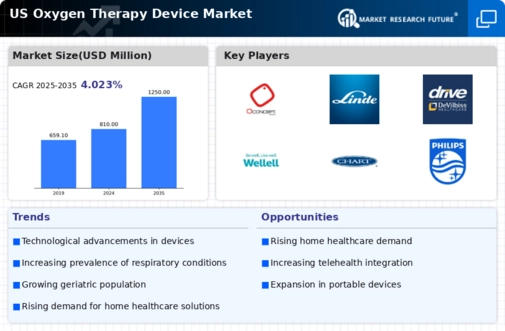Rising Prevalence of Respiratory Disorders
oxygen therapy market Conditions such as chronic obstructive pulmonary disease (COPD) and asthma are becoming more prevalent, affecting millions of individuals. According to the Centers for Disease Control and Prevention (CDC), approximately 16 million Americans are diagnosed with COPD, which necessitates the use of oxygen therapy devices. This growing patient population is likely to boost demand for various oxygen delivery systems, including portable oxygen concentrators and stationary systems. As healthcare providers seek to improve patient outcomes, the oxygen therapy-device market is expected to expand significantly, with projections indicating a growth rate of around 8% annually over the next few years. This trend underscores the critical role that oxygen therapy plays in managing chronic respiratory conditions and enhancing the quality of life for affected individuals.
Increased Focus on Home Healthcare Solutions
The shift towards home healthcare solutions is a pivotal driver for the oxygen therapy-device market. With a growing emphasis on patient-centered care, healthcare providers are increasingly recommending home-based oxygen therapy for patients with chronic respiratory conditions. This trend is supported by the rising costs of hospital stays and the desire for patients to receive care in the comfort of their homes. The oxygen therapy-device market is benefiting from this transition, as more patients opt for home oxygen therapy systems. According to industry reports, the home healthcare segment is projected to account for over 50% of the market share by 2026. This shift not only enhances patient satisfaction but also reduces the burden on healthcare facilities, indicating a promising future for the oxygen therapy-device market as home healthcare continues to expand.
Regulatory Support and Reimbursement Policies
Regulatory support and favorable reimbursement policies are crucial drivers for the oxygen therapy-device market. The US government has implemented various policies to ensure that patients have access to necessary medical devices, including oxygen therapy systems. Medicare and Medicaid programs provide coverage for oxygen therapy, which encourages patients to seek treatment. This financial support is vital for individuals who may otherwise be unable to afford such devices. Additionally, the Food and Drug Administration (FDA) continues to streamline the approval process for new oxygen therapy devices, fostering innovation within the market. As reimbursement policies evolve to include more comprehensive coverage for home healthcare solutions, the oxygen therapy-device market is likely to experience sustained growth. Projections indicate that the market could reach a valuation of $4 billion by 2028, driven by these supportive regulatory frameworks.
Aging Population and Increased Healthcare Needs
oxygen therapy market As individuals age, they often experience a decline in lung function and an increased risk of respiratory diseases. The US Census Bureau projects that by 2030, all baby boomers will be over 65 years old, leading to a surge in healthcare needs, including oxygen therapy. This demographic shift is likely to drive demand for oxygen therapy devices, as older adults are more susceptible to conditions requiring supplemental oxygen. Furthermore, the healthcare system is adapting to cater to this demographic, with a focus on home healthcare solutions. The oxygen therapy-device market is poised for growth, with estimates suggesting a market value exceeding $3 billion by 2027, reflecting the increasing reliance on oxygen therapy for the elderly population.
Technological Innovations in Oxygen Delivery Systems
Technological advancements in oxygen delivery systems are reshaping the oxygen therapy-device market. Innovations such as portable oxygen concentrators, which are lightweight and user-friendly, are gaining traction among patients who require mobility. These devices offer a more convenient alternative to traditional oxygen tanks, allowing users to maintain an active lifestyle. Additionally, advancements in smart technology, including mobile applications that monitor oxygen levels, are enhancing patient engagement and adherence to therapy. The integration of telehealth services with oxygen therapy is also emerging, enabling healthcare providers to remotely monitor patients' conditions. This trend is likely to drive market growth, as patients increasingly seek devices that offer both functionality and ease of use. The oxygen therapy-device market is expected to witness a compound annual growth rate (CAGR) of approximately 7% over the next five years, driven by these technological innovations.




















Leave a Comment